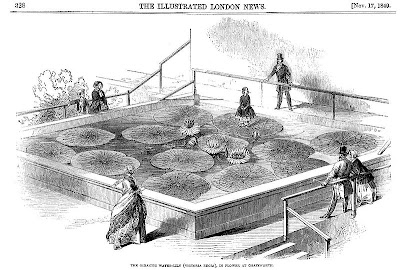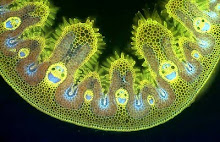The giant Amazonian water lily Victoria amazonica is an expensive plant to cultivate, requiring a very large glasshouse with a deep, heated pool..... deeper water producing larger leaves. It was originally discovered in Guiana by the Victorian explorer Sir Robert Schomburgk in 1837, although a German called Poeppig had earlier seen and described it while rafting down the Amazon. This led to a good deal of confusion over naming of this aquatic giant. According to the arcane but rigid rules of botanical nomenclature it should correctly be called Victoria amazonica but throughout the reign of Queen Victoria it was known as Victoria regia (literally Queen Victoria) and only assumed its botanically correct name after the old Queen died and it was safe to change the labels. Once the first seeds were brought back to England there was a race amongst the landed gentry to be the first to cultivate the plant and present a flower to the Queen, victory going to the Duke of Devonshire whose head gardener at Chatsworth, Joseph Paxton, built a suitably large glasshouse to accommodate the monster plant ... with no expense spared.
One of the most remarkable features of this plant is that it can be grown as an annual, with seeds being germinated in late winter and then transplanted into a heated pool in late spring. By mid-summer the gigantic leaves are well developed and the spectacular flowers form. These only last for two days. On the first evening they open overnight (attracting beetle pollinators in the wild) then close, trapping their pollinators within (you can watch a movie of this here). Once pollinated they flush pink, open to release the captive beetles then sink below the water to develop a seed capsule. Harvesting the seed capsules in a botanic garden is hazardous - you need a wetsuit to protect you from the plant's vicious underwater spines on the stems and underside of the leaf.
The undersides of the giant leaves inspired one of the most famous examples of Victorian architecture. Noting the wonderful structural bracing formed by the massive leaf veins on the underside of the leaves, Joseph Paxton sketched the competition-winning design for the building that housed the 1851 Great Exhibition in Hyde Park – compare the photo of the veins above with the contemporary illustration of the end gable of the building here. The adventurous design, at the cutting edge of engineering in its day and constructed with cast iron framing and the largest panes of plate glass then manufactured, became known as the Crystal Palace and was a wonder of the age, earning Paxton a knighthood.
The Gigantic Waterlily (Victoria Regia), In Flower At Chatsworth
Victoria amazonica has been a crowd-puller in botanic gardens ever since the day that Paxton first flowered the plant. The contemporary illustration above, from the Illustrated London News, shows his daughter Annie standing on one of the giant lily pads - a stunt that isn't recommended as although the spiny veins below are extremely tough the leaf itself is relatively delicate - you can poke your finger through it with ease and if a child's leg slipped through between the veins it would be badly lacerated. There are actually two species of Victoria and the photographs above are of the more compact V. cruziana from Paraguay, seen here growing in Durham University Botanic Garden in 2009; this species has purple rather than red leaf undersides. If you are in Durham, it's well worth visiting the plant....
Victoria Regia : or, Illustrations of the Royal water-lily, in a series of figures chiefly made from specimens flowering at Syon and at Kew by Walter Fitch; with descriptions by Sir W.J. Hooker .
http://en.wikipedia.org/wiki/File:Victoria_Regia._(Analyses)_(1851).jpeg




_(1851).jpg)













